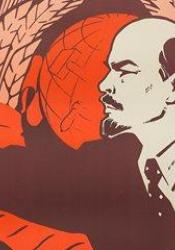The Russian Civil War
From the wake of World War I, Russia was divided. Lenin and the Bolsheviks seized power in the October Revolution. It is important to add that Lenin believed the only way to bring change was through violent uprising and not peaceful change. Once in power, Lenin had pulled Russia out of the war so the nation could focus on rebuilding, specifically by using Marxism to help build the communist state. This revolution and Lenin’s rise to power threw Russia into conflict quickly. Many different people rose up to push back against these Bolshevik ideals.
There were two main groups that were opposing Lenin: the non-Bolshevik left, who had been finally alienated from Lenin by his dissolution of the Constituent Assembly and the rightist Whites, whose main asset was the Volunteer Army in the Kuban steppes. This “White Army” as they called themselves was the biggest opposition to Lenin. It was composed of many different groups but all to go against the Bolshevik Red Army. Multiple battles erupted all throughout Russia. While many of the smaller armies/movements struggled, The White Army held strong and was holding their own against the Bolsheviks. In late 1918, the Bolsheviks only really held power in the western industrial cities because of Allied Germany, treaties, and the White Army’s advances.
Then in November 1918, World War I officially came to an end and the line of Eastern Europe were redrawn. Other countries pulled their troops out and the Bolsheviks saw their chance to push. The Bolsheviks sought dominance over the East and West. Their push east was not too successful, but into the east they spread quickly. With this push the Bolsheviks took dominance fast. This is largely due to the fact that the Bolsheviks had a singular, united goal and a strong leader behind it, while the White Army was more disjointed with many goals throughout the leaders.
In 1919, the White Army was making progress towards Moscow but the Bolsheviks then made an alliance with the Black Army in Ukraine and stopped their advancement and pushed them back. By 1920, the White Army was all but destroyed in the East. The Whites could no longer effectively fight the Black and Red Army. Late 1920 saw Poland and Ukraine form an alliance and launch an offensive against the Bolsheviks in hopes to reunite the Ukrainian State. While they captured Kyiv they were met by a numerically superior Red Army. The Red Army then kept advancing farther into Poland but were halted and the Bolsheviks made a treaty with Poland. This guaranteed Polish independence but left Ukraine under Bolshevik control. With this, the remnants of the White Army fled. Even in this, Lenin saw more opportunity for power and control. With the White Army fleeing, this allowed Lenin to break his alliance with the Black Army and turn on them. They would eventually surrender in 1921. The Bolsheviks would then take over Georgia and Romania to finish off the White Army. The Bolsheviks annexation of the Far Eastern Republic in 1922 effectively ended the war and created the Soviet Union.
The revolution and war displayed the ruthless power-grabbing mindset under Lenin and the Bolsheviks that has led to so much of what modern Russia has become. Lenin’s ideals and effect on history still have weight and repercussions in the present. Russia and Ukraine are still dealing with the trickle-down effect of this complex history. The grasping for power at the expense of others is still something that weighs on these countries as we can see in Ukraine today.
Works Cited
Reiman, Michael. “About the Russian Revolution of 1917.” About Russia, Its Revolutions, Its Development and Its Present, Peter Lang AG, 2016, pp. 13–24, http://www.jstor.org/stable/j.ctv2t4dn7.4. Accessed 26 Apr. 2022

